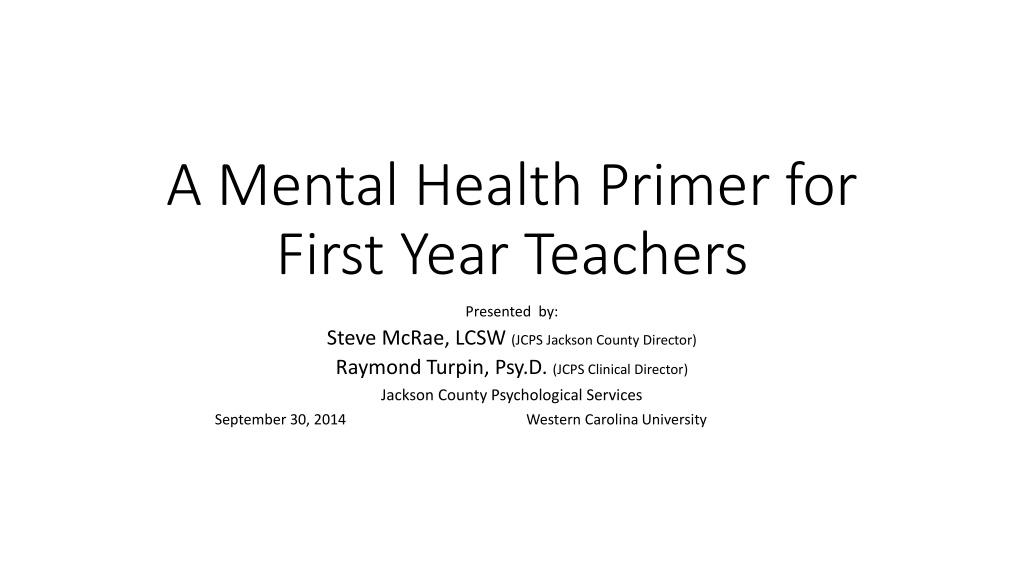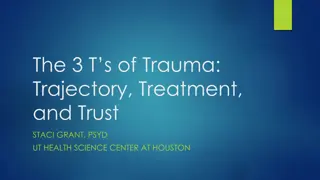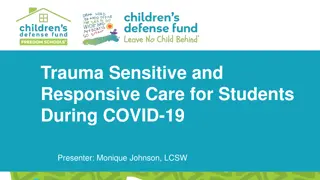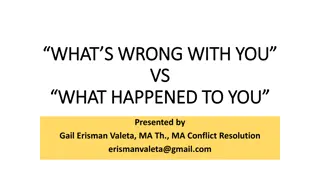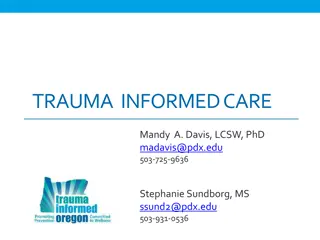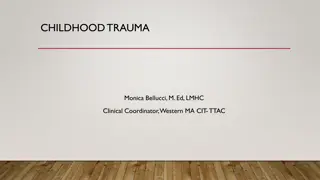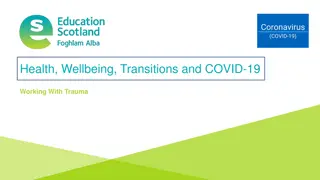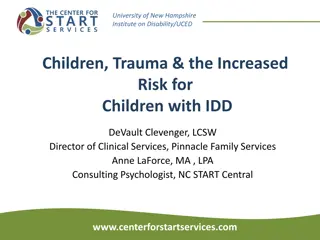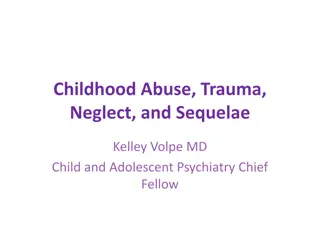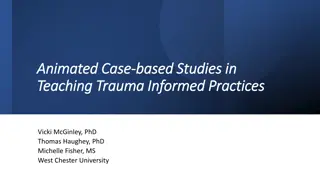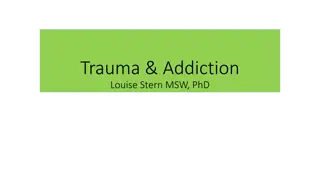Understanding Trauma and Its Impact on Development and Learning
Trauma, whether experienced, witnessed, or confronted, can have profound effects on development and learning, affecting basic human relationships, personality formation, and belief systems. Children exposed to repeated trauma face significant challenges in adaptation, often relying on immature psychological defenses. Recognizing the prevalence of psychological trauma is essential for educators to provide appropriate support and intervention strategies for students.
Download Presentation

Please find below an Image/Link to download the presentation.
The content on the website is provided AS IS for your information and personal use only. It may not be sold, licensed, or shared on other websites without obtaining consent from the author. Download presentation by click this link. If you encounter any issues during the download, it is possible that the publisher has removed the file from their server.
E N D
Presentation Transcript
A Mental Health Primer for First Year Teachers Presented by: Steve McRae, LCSW (JCPS Jackson County Director) Raymond Turpin, Psy.D. (JCPS Clinical Director) Jackson County Psychological Services September 30, 2014 Western Carolina University
Topics Ahead Topics Ahead Trauma and Its Effects on Development and Learning Self-Injury (Cutting) and How to Respond What to Know About School Violence Threats Signs of Suicidal Behavior and When To Take It Seriously
Trauma and Its Effects on Development and Learning
DSM5 Definition of Traumatic Event An event that is experienced, witnessed, or confronted that involves actual or threatened death or serious injury, or a threat to the physical integrity of self or others. The person s response to this event involves intense fear, helplessness, or horror. In children, this may be expressed instead as disorganized or agitated behavior. For kids, this could be: Physical Abuse Domestic Violence Sexual Abuse Emergency Medical Procedure Neglect Accident Death of a Parent Emotional Abuse Bullying
Traumatic events call into question basic human relationships. They breach the attachments of family, friendship, love and community. They shatter the construction of the self that is formed and sustained in relation to others. They undermine the belief systems that give meaning to human experience. They violate the victim into a state of existential crisis. Judith Lewis Herman, MD author of Trauma and Recovery
Repeated trauma in childhood forms and deforms the personality. The child trapped in an abusive environment is faced with formidable tasks of adaptation. She must find a way to preserve a sense of trust in people who are untrustworthy, safety in a situation that is unsafe, control in a situation that is terrifyingly unpredictable, power in a situation of helplessness. Unable to care for or protect herself, she must compensate for the failures of adult care and protection with the only means at her disposal, an immature system of psychological defenses. Judith L. Herman, MD psychiatrist and author of Trauma and Recovery
Prevalence of Psychological Trauma Prevalence of Psychological Trauma Current policy and practice responses do not match in urgency, depth, or quality the epidemic levels of trauma symptoms among children and youth. National Center for Children in Poverty (2007)
Prevalence Facts Estimated 90% of U.S. population will be exposed to a traumatic event over the course of their lives. At least 25% (perhaps up to 40%) of youth in the U.S. will experience at least one significant, potentially traumatizing event by age 16. Many of these youth experience multiple or chronic trauma events these are usually the kids with the most profound effects.
Trauma Facts 18% of those who grow up in an abusive home attempt or commit suicide. Childhood trauma greatly impacts the ability to learn: 30% of those who were abused as children have language or cognitive impairment; 50% have problems in school; 22% have been labeled learning disabled; 25% need special ed classes 25% of all foster children suffer from PTSD (higher % than war veterans)
Factors Impacting the Severity of the Trauma Response Factors Impacting the Severity of the Trauma Response Nature of the Trauma: *Chronic vs. Episodic vs. Single Event *Proximity: Personal Victim Loved One/Friend Witness See on TV Hear about trauma *Suddenness/Lack of Predictability *Degree of: Physical Contact Force Injury Invasiveness
Other Factors Impacting the Severity of the Trauma Response Other Factors Impacting the Severity of the Trauma Response Level of Disruption in Life Level of Social Support (#1 buffer; foster homes) Parental Response (Supportive, Overwhelmed, Minimizing, Denial, Guilt Induction, Anger) Ongoing Medical Problems (reminder) Presence of Guilt/Self-Blame
Trauma is when your biology is assaulted in such a way that you might not be able to reset yourself. Bessel van der Kolk,MD
Fight Fight & & Flight Response Patterns Flight Response Patterns Going from Learning to Survival Mode
In a child who has experienced chronic threats, the result is a brain that exists in a persisting state of fear. Bruce D. Perry, MD
Long Term Effects of Trauma Depression (at least 2x normal risk) Impulse Control Disorders: anger/aggressive behaviors Anxiety Disorders Increased self-harm and suicide risk (significantly) Poorer response to both medications and psychotherapy Trust Problems Sense of Betrayal/Loss of Faith in Adults and Systems Substance Abuse/Dependency Physical Health Problems later in life (ACEs study) Academic Problems Illegal Activities
Effects of Trauma on Children (cont) *Young children (5 and younger) may experience new fears such as separation anxiety or fear of strangers or animals. They may regress and lose previous skills. *Elementary school-aged children (6 to 11) may complain of bodily symptoms w/out medical cause or they may stare into space, seem spacey , or startle easily. *Adolescents (12 to 18) may experience visual, auditory, or bodily flashbacks, have unwanted thoughts or images of the events, demonstrate impulsive and aggressive behaviors, or use alcohol or drugs to try and feel better. They may feel depressed or have suicidal thoughts.
What To Do For A Child Dealing With Trauma If you see a student having a meltdown there is a chance that he or she could be struggling with hyperarousal related to trauma. Calmly tell the student that things are alright and invite them to go to a quiet place away from witnesses and unnecessary stimulation. Try to calm them by suggesting that they take some deep slow breaths while reassuring them they are OK and safe. Ask them about what is going on in a sensitive, non-judgmental way and prepare to listen carefully to the student. Refer them to the school counselor for follow-up.
Self-Injury (Cutting) and How to Respond
Definition Self-mutilation or self-injurious behavior (SIB) is defined as a variety of behaviors in which an individual purposefully inflicts harm to his or her body for purposes not socially recognized or sanctioned and without the obvious intention of committing suicide. Alderman, 1997; Favazza 1996 A purposeful act of self-help.
Cutting is done secretly, usually in a trancelike state, and the act of creating pain or drawing blood, is in itself the goal. Cutters then develop an addiction to this method of exchanging physical pain for emotional pain. Steven Levenkron Cutting: Understanding and Overcoming Self-Mutilation
self-mutilation is distinct from suicide. Major reviews have upheld this distinction A basic understanding is that a person who truly attempts suicide seeks to end all feelings whereas a person who self- mutilates seeks to feel better. Armando Favazza The Coming of Age of Self-Mutilation Journal of Nervous and Mental Diseases 1998
Self-harm results in part from chronic invalidation, from always being told that your feelings are bad or wrong or inappropriate. Marsha Linehan 1993
Almost 90% of self-injurers say they are discouraged from expressing emotions. Almost 50% report past physical or sexual abuse. Most have low self-esteem. These conditions, coupled with hormone changes, make adolescents especially susceptible to self-injury. There is a real sense of being out of control. This is a way to attack the body to regain control. Karen Conterio co-author of Bodily Harm
Self-mutilation is a desperate attempt to have some control over unbearable feelings of aloneness, loneliness and helplessness. When a teen or young adult has not learned healthy ways of managing these intense feelings, they turn to physical pain as a way to blot out the emotional pain or gain a sense of control over the pain they feel. In a strange way, they are really not trying to hurt themselves they are trying to protect themselves from something even more painful than the physical pain. Dr. Margaret Paul co-author of Healing Your Aloneness
The proximal causes for those who engage in self-injurious behavior in both clinical and community settings are strongly linked to difficulties in regulating strong emotions and coping with stress. Whitlock, Powers, & Eckenrode Developmental Psychology May 2006
It expresses emotional pain or feelings that I am unable to put into words. It puts a punctuation mark on what I m feeling on the inside. It s a way to have control over my body because I can t control anything else in my life. I usually feel like I have a black hole in the pit of my stomach at least if I feel pain, it s better than feeling nothing. I feel relieved and less anxious after I cut. The emotional pain slowly slips away into the physical pain. Anonymous Self-Mutilators
It really hurt but I figured if I could tough it out, it would prove I could get through the other things happening in my life. I then felt an odd sense of peace. I knew it didn t make sense, yet I felt better. For that moment, I was in charge. Caia Pattynama (15yo) Family Circle magazine, July 2011
I think my greatest fear is to be forgotten. A teacher I had last year doesn t even remember my name it makes me think that no one remembers me. How do I know I exist? At least I know I exist when I cut. Self-injury message board post
Self Injuring Facts Self Injuring Facts A few recent studies have shown between 14% and 21% of high school students and between 14% and 35% of psychology students at large public universities have practiced self injury. Generally believed that females are more prone to self injury but more recent studies show a much narrower gap between gender Self injury may be socially contagious (epidemic-like patterns in hospitals and detention facilities)
Self Injuring Facts Self Injuring Facts Self injury often stems from events that occur in the first six years of a child s development. Research shows that the phenomenon appears most commonly associated with middle to upper middle class adolescent girls or young women. They are usually likeable, intelligent, and functional and pose no threat to the safety of others. Many come from a background of abuse or from a home with at least one alcoholic parent. Eating disorders occur much more frequently among self-injurers.
Two Reasons People Self Two Reasons People Self- -Injure Injure
Methods of Self-Injury Cutting: 72% Burning: 35% Self-hitting: 30% Interference w/ wound healing: 22% Hair pulling: 10% Bone Breaking: 8% Multiple methods: 78%
Signs of Possible Self-Injurious Behavior Unexplained or frequent injuries Wearing jeans, long pants or long sleeves consistently-even in warm or hot weather Exhibiting the want for isolation or being alone for long periods of time Blood stains on the inside of clothing Finding hidden razor blades, knives, box cutters and other sharp objects Peers cut or burn themselves
Pattern of Self Pattern of Self- -Injurious Behavior Injurious Behavior Self-injurious behavior follows typical adolescence-limited course that emerges in early adolescence and declines in late adolescence or early adulthood.
The intense emotions that provoke self-injury are transient; they come and go like waves, and if you can stay upright through one, you get some breathing room before the next. The more waves you tolerate without falling over, the stronger you become. Anonymous
Intervening at School Do not ignore the situation. It needs to be addressed immediately. Respond in a calm, non-judgmental way. Do not reprimand the student or send them to the principal as a behavior problem. Don t be afraid to ask the student directly about self-injuring but your tone and words will be important as to not create shame or defensiveness. Ask about suicidal ideation or plans. If reported, consider getting an evaluation with a trained clinician. Let them know that you want to try and assist them with finding help. If you feel competent to do so, demonstrate knowledge and empathy regarding self-injury. Follow your school s protocol in regard to contacting the student s parent. If possible, encourage/empower the student to tell the parent themselves, perhaps with you present as a support.
Intervening with Families Remember that families will often initially react with shock, fear, frustration and confusion. Parents must be educated not to display anger or blame the child. Parents need to know that this is incredibly counterproductive. Ultimatums do not work. Resist the urge to punish or ground them. Do not attempt to confiscate cutting materials. Encourage/coach parent to approach child with understanding and sensitivity. Parents do not need to be focused on how their child s self-injuring reflects on them or the family. The initial goal cannot be to stop the behavior. It must be acceptance and a desire/willingness to understand the behavior. Let the child know they can come talk whenever they are ready. Encourage the parents to seek professional help for their child. Family therapy will need to be a part of treatment.
School Violence Threats And What You Need To Know
School Violence Facts School Violence Facts The most reported crime at school was physical attacks or fights without a weapon Most of the serious crimes occurred in the middle and high schools A larger percentage of violent crimes occurred in city schools and in large schools (over 1000 students) About 25% of the adolescent population is at high risk for psycho-social problems and poor developmental outcomes such as academic failure, alcohol and drug abuse, delinquency, and problems with the law and violence. 20% have a diagnosable mental health disorder at sometime during adolescence, the highest rate for any age group through the life span
Ten Key Findings after Columbine Ten Key Findings after Columbine Violent incidents are rarely impulsive acts Prior to most incidents, others knew Most attackers did not directly threaten targets before the attack No useful profile of the attacker Most attackers engaged in behaviors that caused others to be concerned
Ten Key Findings after Columbine Ten Key Findings after Columbine (cont) Most attackers had difficulty coping with loss/failure. Many considered suicide. Many attackers felt bullied/persecuted. Most attackers had access to weapons. Other students were often involved. Despite law enforcement response, most attacks stopped by other means.
Important Characteristics to Assess Important Characteristics to Assess Leakage (considered to be one of the most important clues that may precede an adolescent s violent act) Low tolerance for frustration Poor coping skills Lack of resiliency Failed love relationship Injustice Collector
Characteristics Characteristics (cont) Signs of depression Narcissism Alienation Dehumanizes others Lack of empathy Exaggerated sense of entitlement Exaggerated or pathological need for attention Masks low self-esteem Anger management problems Intolerance
Characteristics Characteristics (cont) Inappropriate humor Seeks to manipulate others Lack of trust Closed social group Change of behavior Rigid and opinionated Unusual interest in sensational violence Fascination with violent entertainment Negative role models
Characteristics Characteristics (cont) Turbulent parent-child relationship Parents acceptance of pathological behavior Access to weapons Family lack of intimacy Student runs the show in the home No limits or monitoring of TV and internet Student s attachment to school School tolerance for disrespectful behavior Inequitable discipline perceived at school Drugs and alcohol Outside interests The copycat effect
Signs of Suicidal Behavior and When To Take It Seriously (Always)
Suicide Facts Suicide Facts Suicidal behavior is the end result of a complex interaction of psychiatric, social and familial factors. There are far more suicidal attempts and gestures than actual completed suicides. One study estimated that there were 23 suicidal gestures and attempts for every completed suicide. However, 10% of those who attempted suicide went on to a later completed suicide. A youth commits suicide every two hours in the U.S. Suicide claims more adolescents than any disease or natural cause Adolescents now commit suicide at a higher rate than the national average of all ages
